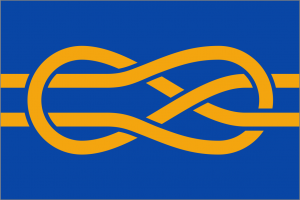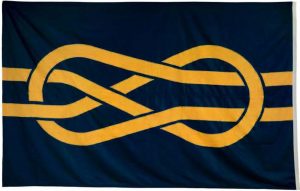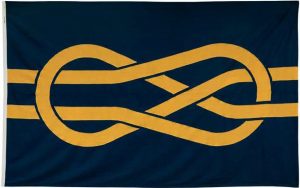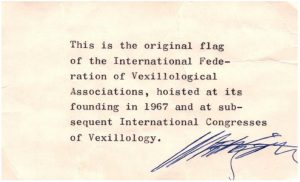Flag and banner of the INTERNATIONAL FEDERATION OF VEXILLOLOGICAL ASSOCIATIONS
On a blue field, extending horizontally from hoist to fly, two yellow halyards forming two interlaced loops.
The halyards allude to the study of flags and banners. The blue field and halyards evoke the maritime origins of the first flags.
The interlaced loops recall the love-knots well-known to heraldists and symbolize the friendship which unites vexillologists of all lands.
The loops formed by the halyards resemble two hemispheres and in adding the four ends of the halyards, we arrive at the number six, standing for the six parts of the world. These elements of the flag thus underline the international character of our Federation. It may also be recalled that blue appears in the flags of a number of international organizations.
The fact that the halyards extend across the whole flag and disappear beyond either end express the considerable – almost infinite – extent of vexillological studies in time and space.
The initial design was created by Klaes Sierksma and slightly modified by the Congress Committee; the final design was realized by Peter Krog. Manufacturer: Schaltegger & Co., Zurich (Owner and Director: E. Oehrli).
Reprinted from Recueil du IIe Congres International de Vexillologie Zurich 196 7, pages 143 and 145.
The FIAV flag was introduced on Sunday, September 3, 1967 at l’lnstitut Gottlieb Duttweiler in Rüschlikon (Zurich), Switzerland. The flag was presented by the then six-year old Guido Mühlemann, son of Louis Mühlemann, the secretary-general of ICV 2 and president of the FIAV provisional council.
In 1967, President Mühlemann presented the original FIAV flag to Whitney Smith. The flag is now a part of the collection of the Flag Research Center.
Originally published as the “History of FIAV’s Flag” in Info-FIAV 12, April 1999, p. 19.
Whatever Happened to the Original 1967 FIAV Flag?
Originally published by Charles A. Spain in Info-FIAV 50, December 2019, pp. 136-139.
If you have been reading Info-FIAV for the past 20 years, then you have read that the whereabouts of the original 1967 FIAV flag are unknown:
Info-FIAV number 19 (August 2001), at page 41:
FIAV Flag Missing
Sometime after the closing luncheon of the Eighteenth International Congress of Vexillology (Victoria, British Columbia, Canada 1999) and before the opening ceremonies of the Nineteenth International Congress of Vexillology (York, England, United Kingdom 2001), the FIAV flag disappeared. Anyone with any knowledge of the flag’s whereabouts is asked to contact the Secretary-General for Congresses (see page one for contact information).
Info-FIAV number 20 (June 2003), at page 4:
Comments to the General Assemby Agenda
Item 14: The Board is extremely concerned by the disappearance of the FIAV Congress flag sometime after the closing luncheon of ICV 18 (Victoria, British Columbia, Canada 1999) and before the opening ceremonies of ICV 19 (York, England, United Kingdom 2001 ). Then-Secretary General for Congresses Bruce Berry passed the flag from the ICV 18 hosts (CFA and NAVA) to the ICV 19 host (Fl) in Victoria, but its location since that time is unknown. The Board believes the flag must either be found or replaced.
Info-FIAV number 21 (July 2005), at page 9:
Minutes of the Eighteenth Session of the FIAV General Assembly, July 28, 2003, Stockholm, Sweden
14. Disappearance of FIAV flag The SG discussed the disappearance of the FIAV flag presented to FIAV at the Second International Congress of Vexillology (Zürich, Switzerland 1967). This is the flag that is traditionally passed—along with the FIAV gavel—at the closing ceremonies from the current Congress organizer to the organizer of the next Congress. The flag disappeared sometime after the closing luncheon of the Eighteenth International
Congress of Vexillology (Victoria, British Columbia, Canada 1999) and before the opening ceremonies of the Nineteenth International Congress of Vexillology (York, England, United Kingdom 2001). In addition, the FIAV gavel has disappeared sometime after the closing dinner of the Nineteenth International Congress of Vexillology (York, England, United Kingdom 2001) and the current Congress. Other than the 3 small officer flags presented in Victoria in 1999 by the Flag Shop and the SG’s records, the FIAV flag and gavel are the only property that belong to FIAV. Accordingly, the Board expressed its extreme concern and its wish that the relevant parties conduct an investigation into the disappearance of the flag and gavel. NF pledged to find the gavel. No commitment was made to find the
flag. Ronald Strachan of National Flag Darwin offered to replace the flag and gavel if they were not found, and the GA applauded his generous offer. [Note: NF informed the SG on August 25, 2003 that it found the gavel.]
Info-FIAV number 22 (July 2007), at pages 19, 20–21:
Minutes of the Nineteenth Session of the FIAV General Assembly, AUGUST 1, 2005, Buenos AIres, Argentina
13. Disappearance of FIAV flag The SG discussed the disappearance of the FIAV flag presented to FIAV at the Second International Congress of Vexillology (Zürich, Switzerland 1967). This is the flag that is traditionally passed—along with the FIAV gavel—at the closing ceremonies from the current Congress organizer to the organizer of the next Congress.
The Board thanked NAVA for bringing to Buenos Aires the FIAV flag that was used at the Eighteenth International Congress of Vexillology (Victoria, British Columbia, Canada, 1999).
A general discussion occurred about replacing the ceremonial FIAV flag. The SG suggested that streamers could be produced for each Congress, but FRC suggested that an individual Congress streamer should not be displayed on the ceremonial FIAV flag until the proceedings for that Congress are published. FSA indicated
its aesthetic opposition to the use of streamers.
….Appendix to the Minutes
….
Disappearance of the FIAV Flag
After examining photographs from past Congresses, the Board has determined that the FIAV flag presented to FIAV at the Second International Congress of Vexillology (Zürich, Switzerland, 1967) disappeared before the Eighteenth International Congress of Vexillology (Victoria, British Columbia, Canada, 1999). The Board does not know when the Zürich flag disappeared, although past Secretary-General for Congresses Ralph Bartlett FF believes it was last seen at the Eleventh International Congress of Vexillology (Madrid, Spain, 1985). Past Secretary-General Emil Dreyer FF confirmed that a new FIAV flag was manufactured for the Fifteenth International Congress of Vexillology (Zürich, Switzerland, 1993).
Past Secretary-General Whitney Smith LF, FF gave the Board the following description of the original Zürich flag:
I cannot remember for certain, but to the best of my recollection the original FIAV flag had the following characteristics. It was 1 meter wide by 1.67 m long and had metal spring clips at top and bottom for attaching it to halyards. It was of heavy blue fabric with the yellow emblem appliquéd on. The workmanship was excellent (e.g. no loose threads or uneven stitches). I believe it bore on the heading a manufacturer’s label from the Swiss company that constructed it.
Past Secretary-General Emil Dreyer FF confirmed that the original manufacturer was “Schalteggher & Co.”
Secretary-General for Congresses Graham Bartram has arranged for the manufacture of a new ceremonial FIAV flag, which will be used at the Twenty-Second International Congress of Vexillology (Berlin, Germany, 2007).
While the Board realizes the importance of recovering, if possible, the original Zürich FIAV flag, the Board has not suggested, and will never suggest, that any Congress organizer or individual has acted improperly. It is, however, the Board’s responsibility to be a good steward of the few physical items that belong to FIAV. Finally, the Board deeply appreciates the assistance of the past Secretaries-General in this matter.
Reading between the lines, you can guess that the ICV 18 and ICV 19 organizers were less than totally happy at the suggestion that the original 1967 FIAV flag disappeared on their watch. The FIAV Board concluded that the original 1967 FIAV flag had not been displayed at an International Congress of Vexillology for some time, perhaps not since ICV 3 (Boston 1969), and after ICV 21 (Buenos Aires 2005), the Secretary-General for Congresses had a FIAV flag made that was brought to ICVs beginning with ICV 22 (Berlin 2007). Info-FIAV number 22 (July 2007), at page 21. [The current official FIAV flag set—organizational flag and three officer flags—was manufactured by Dixie Flag & Banner Company of San Antonio, Texas and purchased by the Vexillological Association of the State of Texas for presentation to FIAV at ICV 26 (Sydney 2015). Info-FIAV number 40 (February 2016), at page 6.]
Jon Radel initially acquired the domain www.FIAV.org on September 17, 1997. A limited FIAV website was authorized at GA 16 (Victoria 1999). Info-FIAV number 15 (November 2000), at page 22 (those limitations currently still apply). However, lack of funds resulted in the domain for a decade being used only for e-mail addresses for the FIAV Board. Info-FIAV number 24 (October 2007), at page 21. Finally, beginning in July 2007, the Board provided the funds to establish a website. Info-FIAV number 24 (October 2007), at page 4. It was also in July 2007 that the Secretary-General completed publishing all past General Assembly minutes in Info-FIAV and made all the past issues of Info-FIAV available on the website. Info-FIAV number 23 (August 2007), at page 1. At that time, the distribution of Info-FIAV shifted from mailing paper copies to e-mailing PDF copies. Info-FIAV number 24 (October 2007), at page 4.
After all the past Info-FIAV became available online, an incredible thing happened. Someone actually read them! In July 2007, the Secretary-General received an e-mail pointing out the following item in Info-FIAV number 12 (April 1999), at page 19, which was a comment to a reprint of the description of the original 1967 FIAV flag in the Recueil du IIe Cong res International de Vexillologie Zurich 1967 [The Proceedings of the Second International Congress of Vexillology], at pages 143 and 145:
History of FIAV’s Flag
The FIAV flag was introduced on Sunday, September 3, 1967 at l’lnstitut Gottlieb Duttweiler in Rüschlikon (Zurich), Switzerland. The flag was presented by the then six-year old Guido Mühlemann, son of Louis Mühlemann, the secretary-general of ICV 2 and president of the FIAV provisional council.
In 1967, President Mühlemann presented the original FIAV flag to Whitney Smith. The flag is now a part of the collection of the Flag Research Center.
While the Secretary-General typed those comments, he has no memory of the source. Presumably it was Dr. Smith. And clearly the Secretary–General had other things on his mind because he completely forgot about the original 1967 FIAV flag being in The Flag Research Center Collection.
After pondering that the answer had been in plain sight since 1999, the Secretary-General contacted Dr. Smith in July 2007, who acknowledged that the original 1967 FIAV flag indeed had been given to The Flag Research Center at ICV 3 (Boston 1969). Dr. Smith indicated that he would consider donating the flag to FIAV, but there also a discussion whether the better course of action would be for the flag to remain with the FRC and end up in a university archive as was Dr. Smith’s plan for the FRC Collection. Because the flag belonged to the FRC, the FIAV Board decided to defer to Dr. Smith.
And so things stood, with VAST separately working with Dr. Smith to place the FRC Collection at the Dolph Briscoe Center for American History at The University of Texas at Austin, which was publically announced by Dr. Smith on October 10, 2010. See Hugh L. Brady, “Gone to Texas: One Account of the Flag Research Center’s Transfer to The University of Texas,” Flag Research Quarterly, number 3, at pages 13–15 (October 2013). By 2010, the assumption was that the original 1967 FIAV flag would go to the Briscoe Center.
On October 23, 2011, Dr. Smith invited a small group of about 25 people—including his sons and people who worked for him—to a lunch in Boston for the 50th anniversary of The Flag Research Center. The Secretary-General was one of those people, and it’s probably best to change to first person at this point. We had a lovely lunch at an event location north of Winchester, and when the lunch was winding down, I became curious about the contents of the gift bag that had been placed at my assigned seat. I asked Carol Salvo, one of Whitney’s assistants, what it was, and she told me, “Whitney wanted you to have it.” When the table had cleared out a bit, I looked in the bag and found a folded flag, with a 3″ x 5″ typed note card signed by Dr. Smith: “This is the original flag of the International Federation of Vexillological Associations, hoisted at its founding in 1967 and at subsequent International Congresses of Vexillology.” I was shocked and deeply moved at Whitney’s trust in me to take care of this object. Later that afternoon at 3 Edgehill Road, I thanked him.
There is not a lot else to say. The flag has been at my house for the past 8 years. My husband John Adcock and I have paid Jonathan Lehmann of Cambiam Creative in St. Louis, Missouri, to professionally photograph the flag and paid Gwen Spicer of Spicer Art Conservation in Delmar, New York, to evaluate, clean, and conserve the flag, as well as place a magnetic mount on the canvas header so that the flag may be displayed vertically. For the rest of my service as a justice on the Court of Appeals for the Fourteenth District of Texas, the flag will be in my chambers in the majestic 1910 Harris County Courthouse in Houston, Texas. I have made arrangements to donate the flag to the Whitney Smith Flag Research Center Collection at the Briscoe Center, where it can become part of the world’s
greatest vexillological collection. I know it’s what Whitney would have wanted. So now you know what really happened to the original 1967 FIAV flag, and here are the photos:
More History of the FIAV Flag
Extracts from “FIAV Flag and Gavel” originally published in Info-FIAV 51, July 2020, pp. 4-12.
Following the intriguing history of the FIAV flag provided in Info-FIAV No. 50 provided by Secretary-General Emeritus Charles A. Spain FF, the new FIAV Board continued to investigate the history of the FIAV Gavel. As can be seen, the stories of the two are intermingled and new interesting information about both the FIAV Flag and Gavel was found in the process.
The FIAV Board contacted notable vexillologists who might have knowledge and/or access to various archives and files of the original members and their kind response has been very revealing. We are most grateful to them and we are using this opportunity to invite others to share their knowledge and stories about the early history and establishment of FIAV which will be published in future Info-FIAV issues.
The following notes on the FIAV Gavel have been kindly provided by Secretary-General Emeritus Emil Dreyer FF, in his mail of April 12, 2020 (all subsequent quotes with minor editing):
Reading through the correspondence of Louis Mühlemann concerning FIAV again, I found his letter of 30 August 1969 to Klaes Sierksma, where he writes about the planned International Vexillological Gathering (which took place from September 12 to 14, 1969).
At the end of the letter he writes a P.S. (translated from the original in German): “For Boston our Swiss Society for Vexillology has sponsored a new FIAV flag, which is thought to remain in America, as well as 60 ARCHIVUM issues. Peter Mäder will not only personally bring the “historic” FIAV flag, but the president’s gavel, which you have sponsored, as well.”
In an earlier letter to Whitney Smith, dated 22 May 1969, Mühlemann tells Smith, that the SSV has only one society flag, 2m x 2m, and having more flags manufactured would be very expensive. He continues by telling him that the SSV could perhaps, at the very most, have a little flag made, 80cm x 80cm. Then Mühlemann asks Smith (translated), “if the Swiss Society for Vexillology should have a second FIAV flag manufactured for the Boston congress”, and continues “though this would be very expensive, since the flag would have to be hand sewn. I would try to get the money to have it done, if necessary”. Obviously, Smith had asked Mühlemann to bring flags to the Boston venue, although I could not find Smith’s letter dated 10 April 1969 according to Mühlemann.… Mühlemann gave the Gavel to Peter Mäder, then secretary of the SSV, together with the original 1967 FIAV Flag, which still was in Mühlemann’s possession. Peter Mäder then handed both the Gavel and the original FIAV Flag over to Whitney Smith at the ICV3 in Boston (which took place between September 5-7, 1969).
Whereas the Gavel has been used at every ICV since Boston, the original FIAV Flag, with a dark shade of blue, seems to have disappeared, with a new FIAV Flag having to be made later in the USA. I don’t know if the original FIAV flag was hoisted at ICV4 in Turin, but probably it was, since I have found no mention whatsoever of any problem with the FIAV Flag in Mühlemann’s correspondence with Natta-Soleri or Ziggioto during the 1970s.In my possession is another FIAV flag, manufactured in 1993 for the ICV15 in Zurich (1m x 1,5m) and an original FIAV streamer, that was offered to the Congress delegates during Captain’s dinner onboard Prinses Christina, the ship on which the ICV6 took place on Jsselmeer, the Netherlands, in 1975. This is “a traditional ship streamer in the FIAV colours and with the FIAV emblem” (Recueil de Congress mondial de Vexillologie VI aux Pays-Bas (ICV6 Proceedings), SHB, Muiderberg, 1975. p. 159). This FIAV streamer had been sponsored by the flagmaker Faber Brothers, the Netherlands. There is no label on the woolen streamer (which must have been a rather expensive gift!). I “rediscovered” the streamer a few years ago in the Mühlemann files in my archives and took it with me to ICV25 Rotterdam 2013, where it flew on board the excursion vessel during the dinner harbour tour.
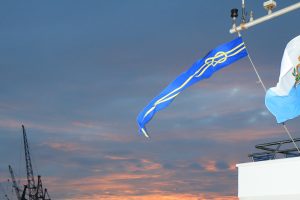
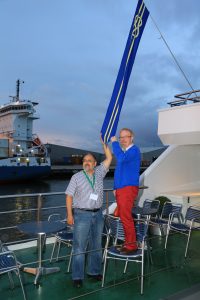
In spite of Mühlemann’s question to Smith about whether a second FIAV flag should be made, and in spite Mühlemann telling Sierksma that the SSV had sponsored a second FIAV flag, no such flag was finally made. Mühlemann himself writes, somewhat contradictorily, in a letter to Sierksma of August 30, 1969, and just after mentioning the sponsoring for the second FIAV flag, that Peter Mäder will bring “not only the original FIAV Flag, but the Gavel as well”. So there were not two FIAV flags.
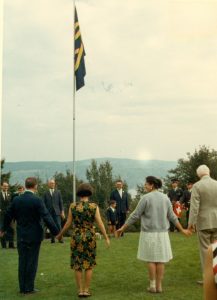
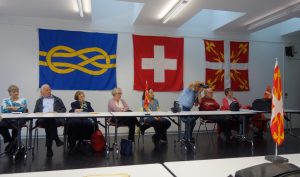
I enclose a photo of the first solemn hoisting of the original dark blue FIAV Flag in Rüschlikon, September 3, 1967, and a picture of the 50th anniversary SSV General Assembly in 2017. This was also the 50th anniversary of FIAV (hence the then FIAV president Michel Lupant being our guest of honour). There you can see the FIAV flag made in 1993 which has a medium shade of blue.
Following the correspondence of April 13 and April 27, 2020, Secretary-General Emeritus Ralph Bartlett FF added the following information on flags in his collection that may be of further interest:
Being part of the “second generation” of vexillologists to have been closely involved in the development of FIAV and ICV’s during the 1990s I can tell you all that shortly after becoming the FIAV Secretary-General for Congresses, I had made at my own expense by a local Melbourne, Australia flag manufacture, my own FIAV Flag, 1,3m X 2m. I keep this with my collection of every ICV Flag that I have attended. I also had Congress Flags made up for ICV11 Madrid, and for ICV15 Zurich, as additional ICV flags were not available for these two Congress. …
Emil Dreyer FF continued researching in the Louis Mühlemann’s archive and on April 26, 2020 reported:
… The two drawings are the two original handmade drawings by Paul Krog of the FIAV flag, dating from August 1967, at the latest. They were used as pattern for the flag manufacturer Schaltegger & Co, whose owner, Mr. Ernst Oehrli, was a founding member of the SSV. One is drawn on white stiff paper, the other bigger one, on brown stiff paper. Black outlines are corrected here and there with white opaque colour.
The original idea for the flag came from Klaes Sierksma. We do not know when the original sketch or flag description by Sierksma arrived in Zurich although there are no documents about it in my archives. […] The Zurich ICV committee (Louis Mühlemann, Klaes Sierskma and Paul Krog) slightly changed the original sketch by Sierksma, and Paul Krog was the one to draw the final pattern on two diferent sheets.
The original dark blue FIAV Flag made by Schaltegger & Co. Which was hoisted on September 3 in Rüschlikon was then kept by Louis Mühlemann until 1969, handed over to Peter Mäder before his departure for Boston (together with the FIAV Gavel) where it was hoisted at the ICV3. We have no exact records of this flag after the Boston ICV, but obviously it remained in the hands of Whitney Smith. I have no records of this flag being used at the ICV4 in Turin 1971, but Whitney was present, and most probably brought the original flag with him to Turin.
In the first issue of Vexilla Italica (I,1 1974, page 5) is a report from the ICV5 in London (13-18 September 1973) translation from the original in Italian): “William Crampton and Whitney Smith have raised the flags of the Congress and of the International Federation of Vexillological Associations, spreading them out on mobile boards.” I guess it was the original dark blue FIAV flag, although it can’t be deduced from the text.
I have no more records about the flag since then. The next congress would be in 1975 on the Ijsellmer, the Netherlands, so possibly the flag may have been handed over to Klaes Sierksma, who was a) to organise the next congress, and b) was the FIAV Secretary-General for Congresses at the time. These two facts make it very probable that Sierskma took the flag with him.
The next congress was in Washington in 1977, so probably at the end of the Ijsellmer Congress Whitney Smith took the flag with him from the Netherlands back to the USA. Anyway, the original dark blue FIAV flag ended up with Whitney Smith, who in turn gave it in 2012 to Charles Spain, then FIAV Secretary-General. Nowadays this flag hangs in the Courthouse Office of Charles Spain in Houston, Texas, as explained in Info-FIAV 50.
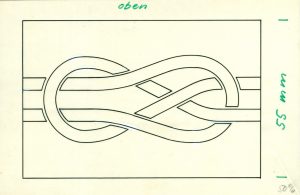
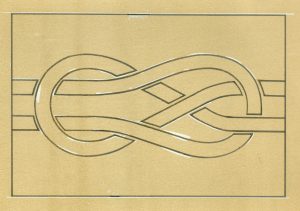
Emil Dreyer FF also located a photo showing the original dark blue FIAV Flag several years later at the opening ceremony of the ICV11 Madrid 1985.
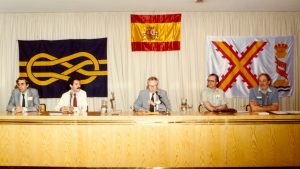
Sitiing from left to right are Tomás Rodriguez, Sebastián Herreros, Rev. Hugh Boudin, Whitney Smith and William Crampton. (Archive E. Dreyer)
Delving deeper in his archives Emil Dreyer FF reported on May 6, 2020 reported:
Here’s the letter dated June 7, 1969, sent by Whitney Smith to Louis Mühlemann. Louis then sent the letter to Peter Mäder with his annotations in red. The German text in red at the bottom, written by Louis Mühelmann, says (translation): “You will hand out personally the big historical flag (deposited at E.Oehrli), and hoist it. I have ordered at friend Oehrli a second, smaller flag (100 X 150 cm) in the name of the SSV; he will send it by Post, so that Smith can add it to the flags in the conference rooms.”
On a side is a handwritten note in French which says (my translation): “In your last letter you addressed me as “docteur ès lettres”, while in fact it’s a doctor in political science (Ph.D.) I won. Slight differences to Europe.”
It seems here, that a second FIAV flag of 1m x 1,5 m was ordered by Mühlemann at the flag factory of E. Oehrli (Schaltegger & Co). Oehrli would send the flag directly to Smith. We do not know for sure if such a second FIAV flag really was made in 1969, if it was sent to Smith, and if so, if it really reached Smith, and if it did, where is it now?
We know that Peter Mäder carried the original 1967 FIAV flag to Boston He carried a SSV flag as well. In the report of the ICV3 in Boston, published as “Notes” in Flag Bulletin VIII/4, it is written: “…The flags of the International Federation and of the Congress itself were hoisted, along with the flags sent by member associations in the Federation.” We know, that those other flags were that of NAVA, of the FRC, of the SSV and of the French vexillological society (which had its flag made just weeks prior to the Congress in haste, omitting the golden ship in the center of the cross, as the flag should have been according to the first SFV statutes. (In the end, the originally intended ship was never added to the SFV flag, the statutes ware later amended.) The Dutch had sent three flags (a Dutch national flag, an Oranje Geus flag and an Amsterdam city flag, but no flag of the NVvV, nor of the SBH. Maybe there were some other flags? In a letter of Smith to Mühlemann, Smith expresses doubts whether he will be able to decorate the conference rooms with flags of the FIAV members, having received no flags up to the present except his own (FRC) and that of NAVA.
In a letter of Mühlemann to Klaes Sierksma, dated August 30, 1969, Mühlemann tells him in the PS at the bottom of the second page in German (translation): “Our Swiss Society for Vexillology has sponsored a new FIAV flag, thought to remain in America, as well as 60 ARCHIVUM. Peter Mäder will not only personally bring the “historic” FIAV flag, but the president’s gavel, which you sponsored, as well. (I still don’t know, who will preside in Boston…).” In this letter again a second FIAV flag is mentioned. I referred to this letter in previous message regarding the Gavel, so here I attach the scans of its two pages.
After these two letters from Mühlemann mentioning a second FIAV flag being made in 1969, I have not found any further mention of it in later correspondence. Did this second FIAV flag really exist? And if not, why should Mühlemann repeatedly mention it? So there must be something about this second flag and the question to be asked, is does anybody know more about it?
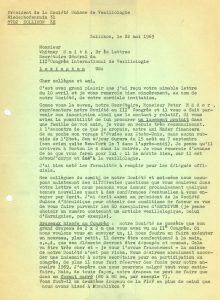
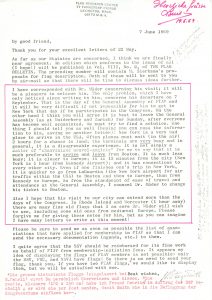
Last Updated on August 14, 2021
